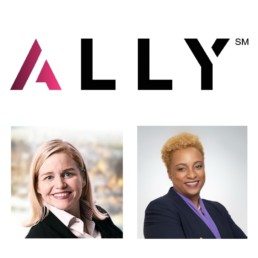Interview: Katie Mehnert and Shanta Eaden, ALLY Energy
We are inspired by people who are passionate about insurance and technology that solves pressing global challenges. In this interview series, our chief actuary, Sherry Huang, talks with friends of New Energy Risk whose work makes a difference, and whose journeys will inspire you, too.
I got to know Katie Mehnert and her company, ALLY Energy, early this year as NER was expanding our team. We decided to post our open positions on ALLY’s job search platform based on our shared values of diversity, equity, and inclusion (DEI). I was also introduced to ALLY’s new COO, Shanta Eaden, who had just joined ALLY with a background in DEI and operations. Inspired by ALLY’s mission to create an equitable energy transition, I set out to talk to Katie and Shanta about their vision for ALLY.
Katie, tell us about what inspired you to start ALLY Energy?
 The idea to create an online community for women in energy was born seven years ago during a flight from London to Houston. I was a safety executive at BP and traveling back home when a fellow passenger asked: “What’s a pretty young lady like you doing in a dark, dangerous business like oil?” A light blub went off for me to fix this perception – both the perception of the oil and energy industry and the need to accelerate the progress for women. Pink Petro was launched a little over a year later on International Women’s Day in 2015. It was a socially charged name, but I wanted to shake the market. At the end of 2020, we worked on rebranding the company and launched ALLY Energy. ALLY represents a force for good and is inspired by my daughter Ally.
The idea to create an online community for women in energy was born seven years ago during a flight from London to Houston. I was a safety executive at BP and traveling back home when a fellow passenger asked: “What’s a pretty young lady like you doing in a dark, dangerous business like oil?” A light blub went off for me to fix this perception – both the perception of the oil and energy industry and the need to accelerate the progress for women. Pink Petro was launched a little over a year later on International Women’s Day in 2015. It was a socially charged name, but I wanted to shake the market. At the end of 2020, we worked on rebranding the company and launched ALLY Energy. ALLY represents a force for good and is inspired by my daughter Ally.
What is your vision for ALLY?
ALLY is an online community for the energy workforce, powering an equitable energy transition.
We are capturing the opportunity that combines a desire to connect in new, meaningful ways and the need for the entire energy industry to work together towards an equitable transition. The vision is to focus on the intersection of equity, environment, and emerging economy and energy transition.
The ALLY Council connects members of the energy industry with resources and best practices to provide a platform for dialogues and actions to address equity and inclusion. Our council members recognize we are in a multi-decade energy transition and need to develop the pipeline for top talent to stay competitive. ALLY’s ESG Council (with a corporate focus on environment, social, and governance issues) allows members to collaborate, share, and learn together on their most pressing ESG issues and celebrate wins. The ALLY platform also includes various awards, podcasts, and publications which promote successful and inspiring women leaders and trail-blazing companies in the industry. The goal is also to create a marketplace with high-quality and high-impact content, and help industry members make sense of the noise and focus on what’s helpful with proof points.
Shanta, tell us a bit more about how you get to where you are today and what are you most excited to achieve at ALLY?
 I was born and raised in Houston, Texas and started my career in the banking industry with an operations focus. I moved to working at Weatherford, an oil and gas service company and started a project management office for a multimillion-dollar IT portfolio. At Weatherford, I also started and led a diversity and inclusion program and supported multiple employee resource groups, which is how I met Katie. Joining ALLY allows me to combine my passion in DEI and my strength and experience in technology and operations to jump on the train with the industry to push for a more equitable workplace and energy transition. I am most excited about learning what companies are looking for in terms of talent and DEI to enable the energy transition, and how we can best service them to enrich the journey.
I was born and raised in Houston, Texas and started my career in the banking industry with an operations focus. I moved to working at Weatherford, an oil and gas service company and started a project management office for a multimillion-dollar IT portfolio. At Weatherford, I also started and led a diversity and inclusion program and supported multiple employee resource groups, which is how I met Katie. Joining ALLY allows me to combine my passion in DEI and my strength and experience in technology and operations to jump on the train with the industry to push for a more equitable workplace and energy transition. I am most excited about learning what companies are looking for in terms of talent and DEI to enable the energy transition, and how we can best service them to enrich the journey.
Katie and Shanta, who is a mentor for you in your careers?
Katie: I have many great mentors and teachers. I am thankful to Sheryl Sandberg; the question she posed, “What would you do if you weren’t afraid?” struck a chord with me and started my journey to create ALLY Energy.
Shanta: My mom, who raised me and my three sisters with such grace. She was a lifetime educator. I look up to her and am thankful of all the values she instilled in me.
Shanta, what data are available on DEI in the energy workforce? Do you believe a more diverse workforce, and more diverse leadership in particular, will accelerate this transition, and how?
There are some standard statistics, such as the distribution of workforce by gender and ethnic background, but even these statistics can be hard to obtain especially with a global operation. For inclusion, other data to track could be retention rate or engagement level. Companies that make an early commitment to track these data will succeed in their DEI objectives. Studies have shown that diversity improves innovation, which improves profitability and enables the innovative energy transition. We need to have decision makers, especially those of majority groups, act on the findings of these studies. Representation matters; young employees early in the pipeline are more likely to grow with the company if they can identify themselves with someone in the leadership group. In 2021, companies cannot afford to ignore diversity and equity in building their human capital strategy.
Congratulations on ALLY’s recent acquisition of Clean Energy Social! Tell us about this acquisition.
Katie: The addition of Clean Energy Social expands ALLY’s platform to unite solar, wind, oil and gas, power and utilities, biofuels, hydrogen, carbon capture and other segments contributing to the energy transition. We can speed up decarbonization by centralizing resources into one digital experience.
Shanta: This acquisition doubles the size of our community and marks the opportunity to build insights into our product to ensure candidates are well-matched with a company. We are excited about the future of our roadmap and look forward to continued growth.
Thank you, Katie and Shanta, for this interview. We are inspired by your authenticity, and your passion and dedication to a more equitable energy workforce and energy transition.
###
The Supreme Court Deals Ethanol a Blow by Undermining the Renewable Fuel Standard
By Brentan Alexander, PhD; Chief Science Officer & Chief Commercial Officer
In June, the US Supreme Court ruled on a protracted legal and political fight that has pitted two pillars of the Republican base against each other since 2018. The case, HollyFrontier Cheyenne Refining, LLC v. Renewable Fuels Association, involved a small refinery in Wyoming that sought relief at the court from a lower court ruling restricting the authority of the US Environmental Protection Agency (EPA) to provide relief to refiners under the Renewable Fuel Standard (RFS). The Supreme Court, in a 6-3 ruling, granted that relief and gave small refiners a win in their ongoing battle to weaken the RFS.
The RFS was established by Congress with the Energy Independence and Security Act of 2007. Formulated during a time of falling US oil production, the RFS mandates blending requirements in the domestic fuel supply for biofuels, primarily corn-ethanol. The legislation has an unusual set of supporters from across the ideological spectrum, as it offsets the use of fossil-based fuels while also providing immense economic benefits to Middle America. Under the RFS, the EPA sets annual “Renewable Volume Obligations” for a variety of biofuels that refiners must blend into finished fuels. To track compliance and enable burden sharing, a market-based system allows obligated parties to trade compliance credits (RINs). The D6 RIN, which relates to corn-ethanol, underpins an ethanol industry that generated more than $46 billion in revenues in 2018 alone.
The cost of the RINs is borne by refiners (and eventually the consumer), who must purchase sufficient RINs to "retire" with the EPA. When the RFS was established, Congress was concerned that the cost of compliance could put small refiners out of business. As a result, they exempted small refiners from RFS mandates for the early years of the program (through 2011) and further established a waiver process to further exempt qualifying refiners from the obligations of the RFS after this initial period if compliance would lead to "disproportionate economic hardship" for the refiner.
This bar was not reached by many petitioners during the Obama years, but upon the start of the Trump presidency in early 2017, the floodgates were opened. The number of waivers granted to refiners skyrocketed from under 10 to over 30 between 2016 and 2018. Large refiners were given waivers, eliminating overnight billions of gallons of ethanol demand. The EPA failed to increase mandates on the remaining obligated refiners to compensate for this reduced demand. Prices for ethanol and the D6 RIN collapsed, and many ethanol plants closed as a result. Chuck Grassley (R-IA) complained that the EPA "screwed us." Unsurprisingly, the ethanol industry sued, starting the journey that led to last week’s Supreme Court decision.
The case came down to the meaning of the word “extension,” which I previously wrote about here. The statutory language allows a “small refinery [to] at any time petition for an extension of the exemption.” Lower courts ruled that an extension is only meaningful if there is a valid in-force exemption to extend in the first place. Under this logic, any lapse in an exemption eliminates any further ability to extend, restricting exemptions to refiners who had valid and continuously granted exemptions from the start of the RFS. Since most exemptions granted under the Trump Administration were to refiners without active exemptions, this decision invalidated a large number of waivers, a major win for the ethanol industry.
The Supreme Court overruled this interpretation. Writing for the majority, Justice Gorsuch found that the ordinary meaning of “extension” does not imply a continuity of the exemption, comparing the situation to a request for an extension on homework. Gorsuch wrote, "Think of the forgetful student who asks for an 'extension' for a term paper after the deadline has passed. The tenant who does the same after overstaying his lease, or parties who negotiate an 'extension' of a contract after its expiration.”
The win for the refiners undercuts the RFS, opening it to further political meddling. With a change in administration, scores of refiners with prior exemptions could apply and get their waivers reinstated, eviscerating ethanol demand. Worse still, an unfriendly administration could simply undo the RFS by rolling back mandates, waivers or not: The EPA is charged under the RFS with setting the blending mandates annually, and the statute provides no guidance on appropriate blend levels after 2022.
It’s too soon to say how the ruling will impact the market and the value of the D6 RIN. Even before this ruling, small refiners had slowed their RIN purchases considerably in the hope of a win, pulling their demand from the market. Prices dropped around 6% after the Supreme Court decision was released, bringing the D6 RIN price to $1.55, down from its 2021 high but still roughly double its value from the start of the year. Markets are likely factoring in the stability of the Biden Administration coupled with continued increases in ethanol demand as COVID impacts ease and oil demand recovers. The RFS seems safe for the near future, but the fate of the program after 2024 remains uncertain.
###
Preview: Project Finance Playbook
This summer, NER is joined by Ross Mazur, impact MBA corporate sustainability fellow from Colorado State University. Ross, a mechanical engineer and project manager focused on renewable fuels, is learning and contributing across our business development and diligence teams. By the conclusion of his fellowship, he will have co-authored a company whitepaper, which he previews for us here.
By Ross Mazur; Impact MBA Corporate Sustainability Fellow
Behind the scenes at NER, we’re drafting a whitepaper, the Project Finance Playbook, which will demonstrate how project finance is often a superior method to finance capital intensive first commercial technology deployments. The Playbook is structured to be both accessible and actionable to startups in the emerging energy and carbon technology space.
The Playbook will recount a brief history of project finance (having roots in Roman cargo-carrying merchant voyages). It will also explore the opportunities inherent in project finance, including risk management and minimally dilutive completion of large capital intensive projects. It then discusses project finance conceptual theory, with an emphasis on overcoming interest alignment challenges via purpose-driven contractual structures. The next section, full of acronyms, walks through project finance key stakeholder contract types, including construction contracts. Debt and equity sizing and market assessment are then reviewed to help identify applicable lenders and investors. And that’s just the first chapter!
The second chapter walks through commercial requirements, focusing on market strategy, building a term sheet, and the role of project risk and a credit rating mindset to speed-up development cycles and decrease time to financial close. The third chapter describes technical requirements, going into the details of scale-up strategy and development program planning to be best suited for proving efficacy of a technology at commercial scale. The last chapter, “A Vision for Success,” connects the dots for an energy technologist (or project developer) to more confidently navigate the project finance process.
The Playbook will be out by the end of the summer and we look forward to sharing it with our network. We appreciate peer review and we would be glad to hear (and possibly reference!) your perspectives on the topic. Or if you are just excited about the concept and would like to be notified when the Playbook is released, subscribe to our newsletter or reach out to us at [email protected].
###
Interview: Dr. Jessica Morris, Expert Engineer in Atmospheric Dispersion, Exponent
We are inspired by people who are passionate about insurance and technology that solves pressing global challenges. In this interview series, our chief actuary, Sherry Huang, talks with friends of New Energy Risk whose work makes a difference, and whose journeys will inspire you, too.
This interview has been lightly edited for clarity.
Dr. Jessica M. Morris is a senior associate specializing in fluid dynamics and safety in the Thermal Sciences practice at Exponent, an engineering and scientific consulting firm. I reached out to Dr. Morris through Dr. Sean Dee, someone we have worked with in the past. I enjoy talking with women scientists and engineers to learn about their unique career paths, and I had a terrific time getting to know Dr. Morris, who is positive, disciplined, and passionate about helping and inspiring others.
You have such an interesting and impressive career path. How did you decide to pursue a PhD in engineering and get to where you are today?

I completed my undergraduate coursework in chemical engineering at the University of Minnesota at Duluth. Due to a clerical error in my graduation date, I was required to continue with courses for an additional semester in the fall. I decided to make the most of the additional learning opportunity. I continued working part-time as a pharmacy technician, as well as working as a teaching assistant for the Chemical Engineering department. I attended a talk on “fracking” presented by a professor at the University of Arkansas. This professor was super nice, very personable, and most importantly very into what he researched. After the talk, this professor asked several students if they were interested in graduate school. The idea of earning a PhD in engineering had not crossed my mind before, since it was not an option when I was contracted with the Air Force, but I had received news of approval for an honorable discharge two days prior. I was at a crossroads and needed to figure out my future and pursue other opportunities. This professor received my resume from our department head the next day, and several days later offered me a full-ride scholarship and stipend for graduate school. I was thrilled to tour the university where I had the opportunity for a fully-funded doctorate in chemical engineering.
Research focuses at the Chemical Hazards Research Center were highly applicable to a real-world industry setting, which set me up for success. I felt at home with focus areas that were directly related to my interests, having minored in aerospace and environmental engineering. The mentorship was another selling point for the program; I was set up with a very well-respected and attentive advisor, Dr. Tom O. Spicer. I was grateful to have funding through DNV GL and the Dutch government, which gave me the opportunity to work in London during my PhD. Everything fell into place. While a myriad of factors played a role in my choice to pursue a doctorate in engineering, I believe my willingness to engage with others, openness to new opportunities, and work ethic were of the greatest importance in the pursuit of my career.
I ended up at Exponent through meeting a representative from Exponent at an industry conference, the Global Congress on Process Safety, during the last year of my PhD. He invited me to participate in the Loss Prevention Symposium committee the following year due to my research, but then took the time to tell me about Exponent and the engineering consulting field. Exponent turned out to be the perfect fit for me, as I get to utilize the expertise I built in my graduate program, communicate technical findings to a variety of clients, participate in numerous professional development opportunities, and continue to learn about new technologies across multiple fields.
What are some of the unique perspectives you and other women engineering leaders bring to the team?
Although growing, there still are not many women in the engineering field. In many situations, I have found myself being the only woman in the room. While sharing stories of biases we have collectively faced leads to greater awareness, more must be done to facilitate advocacy. It is important that we support our peers and do not stand by as witnesses to bias in the workplace. Acknowledging bias supports the individual facing the discrimination, and also has an impact on the overall office culture. For example, in the workplace women are interrupted at a rate much higher than men, which greatly impacts the ability of women to share their ideas in a professional setting. Supporting other women by addressing interruptions can be helpful in changing office culture. The statement “what were you saying before you were interrupted?” can be a helpful way to allow women to continue having a voice. It is important to me to be an advocate for others. I am aware of the challenges women and minorities face in the workplace and if I can make it easier for someone coming in by giving advice or sharing my mistakes to make them more successful, I will always take the time to do that.
What are some of your passions outside of work?
I am passionate about working with kids and acting as a role model for them. I think the challenge of hiring more diverse talents needs to be addressed at a younger age. Kids often decide to pursue a STEM path in middle school, so providing a positive learning environment and more role models for them during this age is so important. I participated in multiple inner-city middle school mission trips in the past and continue to participate in the “Skype a Scientist” program. I am currently in training to become a Court Appointed Special Advocate®/guardian ad litem volunteer to advocate for children who have experienced abuse or neglect.
Do you have a mentor in your career who helped you find the way?
I am grateful to have had positive mentorships in several settings. I have found mentors care about my professional growth, as well as my personal development. Just because someone is assigned to you, does not mean that they are always going to be your mentor or have your best interest in mind. It is on you who you choose to be in your life, to go to for help, and especially to go to for advice. Throughout a career, you will need to seek mentorship through multiple avenues. Each job, each opportunity, each milestone in life, I have had a great network made up of multiple people that are cheering me on. From classmates helping me get through my undergraduate degree, knowledge shared by my advisor while completing my doctorate, supportive coworkers providing real-world experience, and managers who have taken the time to help me in my professional path forward and personal life, I could not have reached each milestone without all of the different mentors and support I have had along the way. I have been lucky to have had the support of the many individuals who have influenced my career path.
Thank you, Dr. Morris!
###
Building a Better Backstop
11 Considerations for Project Sponsors Comparing Government Backstops and Private Sector Solutions
By Matt Lucas, PhD; Managing Director, Business Development
At New Energy Risk (NER), we cheered the recent announcement that clean energy leader and icon Jigar Shah would be leading the DOE’s Loan Programs Office (LPO). We share his goal of seeing the office streamlined to maximize its effectiveness. We have interacted with both DOE and USDA loan guarantee programs for multiple years and have first-hand experience: One of my colleagues led his former company’s successful LPO application process.
Given the need to deploy hundreds of billions of dollars to meet climate mitigation goals, create post-pandemic jobs, and commercialize frontier technologies, there’s room for all sources of capital. We hope this post will inform project sponsors and highlight factors to consider when evaluating their project financing options.
Coverage Triggers: Key Differences Between Government and Private Solutions
It is important to understand how government loan guarantees and private-sector solutions work in a downside scenario. Although similar in intent—both solutions protect project lenders—the mechanism of coverage is different, which has significant impacts on project owners, equity investors, workers, and other stakeholders.
For government loan guarantees, the project is expected to exhaust all its contingencies, maintenance reserve, and debt service reserve in the event of revenue shortfalls. If the project is unable to meet its debt service obligations after these measures, then the project would be in Default (with a big ‘D’) of the loan. To recover its investment, the lender is required to foreclose on the project and liquidate the assets. The bank is then audited by the government and only then does the government pay the bank for the portion of the debt it was unable to recover. Project owners and equity are on the outside looking in, with their investment completely wiped out.
The impacts of this are severe: The sponsor and all equity has been zeroed out, the project has been shuttered and liquidated, and the technology has suffered a very public failure that will be adverse to any future financings. The government might have succeeded in making the bank whole (notwithstanding the challenging liquidation and audit processes), but every other stakeholder has been thrown to the wolves, the technology will not be commercialized, and the carbon mitigation and jobs co-benefits go unrealized.
NER has a better solution that ultimately protects the lender while also benefitting other project stakeholders. We also help protect capital at risk, including but not limited to senior debt. While there are efficiencies in time and cost ahead of financial closing (see considerations below), the key difference is that our solutions are designed to avoid a lender default, preserve the project, and secure a cure. Unlike the government loan guarantees, which provide after-default support to the bank, we step in earlier to support the project and avoid a default in the first place. While the insurance might directly benefit a lender, this design also benefits subordinate and equity investors who would otherwise be washed out and workers who would lose their jobs, and gives the technology a chance to be improved and repaired. NER could be compared to a standby lender, providing necessary liquidity to project sponsors to service debt while enacting cures or fixes to restore project health.
11 Considerations for Project Sponsors When Comparing Backstops
Total Cost of Debt
The cost of debt is more than the cost of capital: Government capital is probably the cheapest option on the market, but this is often balanced by other advantages of private debt. As Jigar noted on a trade group call, “[LPO] is a commercial bank so we price where the banks should price. We are not subsidizing capital.” Jigar provided a median estimate for an all-in cost of debt from LPO of 5.5-6.0%, based on a fixed cost of capital from Treasury around 2.0%.Bank or bond borrowing, when coupled with insurance solutions such as NER’s, can provide comparable pricing. As of this writing, 10-year Treasury (1.66%) and BBB spread (1.15%) leave a private cost of capital (2.81%), near the LPO’s cost from Treasury. With 300+ bp of spread for the lender and insurance, it is possible to provide private-sector senior debt on similar terms. Our clients Fulcrum BioEnergy closed on over $100M in financing on 20-year notes in 2017 at 6.25% and Brightmark (formerly RES Polyflow) closed on 20-year paper at 7% in 2019.
Time to Close
There is always a rush to get projects financed. A bank loan can close in three months. A bond offering might take four to five months. NER can close in as little as three months.The government works on a different timescale. Jigar acknowledged that timelines for LPO can be long and he’s working to streamline that. Historically, projects have had to march through a multi-stage process that routinely drags on for a year or more. Anecdotally, one of our clients just took 4.5 months to receive back their initial review.
Underwriting Fees
In his recent podcast, Jigar said that typical underwriting and closing fees (outside the risk premium) are $2M. These fees must be borne by a project even if a closing is never achieved and are accrued prior to receiving a term sheet. For this reason, LPO is most appropriate for larger loans. Anecdotally, one of our clients incurred more than twice this cost just to reach a term sheet (not yet closed).By contrast, NER’s fees for underwriting and closing are more than an order-of-magnitude lower. While LPO can defer and even waive fees, the process is uncertain, while we require no similar efforts.Another distinction is when third-party reports are due, such as market reports and the independent engineering report (and must be paid for by the sponsor). LPO requires these documents prior to offering a priced term sheet. By contrast, a private lender would only require the reports as a condition for financial close. By delaying these transaction costs for the sponsor, private lenders align costs with certainty of reaching financial closing.
Certainty of Closing
Sponsors seek to de-risk their projects and increase certainty. NER has a decade-long track record of delivering The Power of Certainty™ to our customers. 100% of our engaged clients have received priced term sheets and 100% of accepted term sheets have resulted in approved policies.The government has additional requirements that increase execution risk. These include a “policy factors” review by Office of Management and Budget, minimum credit ratings for key counterparties, required credit rating opinion on the project, and in some cases a National Environmental Policy Act (NEPA) review, which can take up to 24 months.
International Expansion and Capital Limitations
Government loan guarantees only support projects in the US and have limits on how many projects of a certain type they will support. Since it takes five to eight years of robust operations to achieve bankability without a government or private backstop, LPO’s limitations can impact domestic growth after project one or international growth. NER can support your entire portfolio, both domestically and abroad. Having a single partner with a single diligence for your entire portfolio smooths execution.
Covenants and Other Restrictions
Loan agreements include standard covenants that ensure good project governance, but additional covenants can be constraining to sponsors in a detrimental way. LPO covenants include dividend restrictions, made-in-America requirements, and qualifications on equity sponsorship. These are not typical of private lending and are not required by NER.
Flexible Capital Structures
NER supports a variety of capital structures including senior debt, mezzanine and sub-debt, tax equity, preferred equity, and combinations of the above. Government loan guarantees are limited to senior debt. We can support other capital tranches, in conjunction with government guarantees, if it makes sense to do so.
A Partner, Not a Bank
NER aims to be your partner in executing your project. In the last few months, we’ve leaned in to connect our clients with EPCs, lenders, equity investors, bankers, and LCA consultants. LPO, as a governmental agency, is restricted in its ability to make connections to key counterparties due to confidentiality concerns and the need for the government to remain neutral.
Project-Level Workout Vs. Bank-Level Guarantee
A government loan guarantee is designed to pay the lender in the event of a loss but does not help avoid the project default in the first place. In contrast, NER seeks to avoid a lender default from occurring by stepping in sooner and achieving an early workout at the project level. This approach is advantageous for the project, benefitting subordinate investors and workers, and allowing the project to return to operational and financial health.
Amount of Debt Capital Required
If a project requires more than $1B of debt capital, then working with a government program is the right choice. However, most first- or first-few-of-a-kind projects require vastly less debt, making a government program less attractive. In any case, larger projects are often best structured as multiple phases/tranches to segment risk, which also allows for private backstops.
Offtake Risks
LPO works with public dollars and helps projects ensure commercial risks are minimized, while often being overly conservative and going beyond levels that the private market would bear. Previously, LPO urged fixed priced offtakes, which are not available for some projects. Jigar shared that LPO will now consider indexed offtakes with Renewable Fuel Standard (RFS) and Low-Carbon Fuel Standard (LCFS) credits for bioeconomy projects, which is promising. NER will work with projects that have commercial risks acceptable in the private markets. We routinely support projects without fixed priced offtakes. In the bioeconomy, offtakes rarely match the debt terms and are typically indexed rather than fixed price, and can be heavily dependent on RFS or LCFS revenues. In some circumstances we can also hedge these credit prices.
Thinking about how to fund your project? New Energy Risk is often the first partner aligned to help with the financing of a project, so we serve as a sounding board and advisor to sponsors as they consider their multiple capitalization pathways. We look forward to partnering with you to help your project achieve funding.
###
Oil and Ethanol Fight at the Supreme Court Over the Word “Extension”
By Brentan Alexander, PhD; Chief Science Officer & Chief Commercial Officer
A protracted legal and political fight that has pitted two pillars of the Republican base against each other reached its apex last week as the Supreme Court heard arguments in HollyFrontier Cheyenne Refining, LLC v. Renewable Fuels Association. At issue is the authority of the US Environmental Protection Agency (EPA) to provide relief to refiners under the Renewable Fuel Standard (RFS), which mandates blending requirements in the domestic fuel supply for biofuels, primarily corn-ethanol. Refiners argue that EPA’s authority (including to offer waivers) is broad, while the farm lobby counters that the authority is limited. The outcome of the case rests on how the nine justices interpret the meaning of the word “extension.” Their decision has the potential to enormously affect the value of ethanol in the US, directly driving corn prices and economies in the US heartland.
The RFS regulation was established by Congress with the Energy Independence and Security Act of 2007. Formulated during a time of falling US oil production, the RFS biofuels blending requirement strategy was seen both as an economic benefit to Middle America and a way to fortify domestic energy security. Under the RFS, the EPA sets annual “Renewable Volume Obligations” for a variety of biofuels that refiners must blend into finished fuels. To track compliance and enable burden sharing, the RFS established a market-based system that allows obligated parties to trade compliance credits (RINs). These RINs have a fluctuating value depending on supply and demand of biofuels in the market, and the D6 RIN, which relates to corn-ethanol, has been an important economic driver for growers in the Midwest. The program underpins the ethanol industry, which generated more than $46 billion in revenues in 2018 alone.
The cost of the RINs is borne by refiners (and eventually the consumer), who must purchase sufficient RINs to ”retire” with the EPA to satisfy their mandate. To aid small refiners from the added compliance costs, the RFS includes a waiver process designed to exempt qualifying refiners from the obligations of the RFS. Through a petition to the EPA, qualifying refiners can be granted temporary exemptions from blending mandates if the EPA, in consultation with the Department of Energy, finds that RFS compliance would lead to “disproportionate economic hardship” for the petitioner.
The difficulty for corn growers is that this exemption program was expanded considerably during the Trump administration. The number of waivers granted to refiners skyrocketed from under 10 to over 30 in the first two years of the administration. Even large refiners were given waivers, and the EPA failed to increase mandates on other refiners to compensate for the missing gallons, effectively reducing demand for biofuels by billions of gallons overnight. Prices for ethanol and the D6 RIN collapsed. Many ethanol plants closed as a result. Incensed, Chuck Grassley (R-IA) noted that the EPA “screwed us” and the lobbyists for farmers and ethanol producers unloaded criticism on administration officials. A lawsuit followed, claiming the EPA overstepped its bounds in issuing the waivers.
That lawsuit was decided by lower courts on the interpretation of the statutory language. The RFS rules state that small refiners (under 75,000 bbl/day) did not need to comply with the RFS until 2011, and those refiners meeting the disproportionate economic hardship threshold were allowed a temporary exemption valid for an additional two years. The next paragraph in the statute further allows that a “small refinery may at any time petition for an extension of the exemption.” The 10th Circuit focused on the word “extension” and ruled that exemptions are only valid if they are extensions of exemptions previously and continuously granted from the start of the RFS. Most exemptions put in place under the Trump administration therefore didn’t qualify. The decision was a major win for the ethanol industry, and the value of the corn-ethanol D6 RIN has increased over 400% since the decision was handed down.
Three small refiners in Wyoming, who have not had continuous exemptions, challenged that ruling, paving the way for last week’s oral arguments at the Supreme Court. As expected, the justices focused on the word “extension,” working to determine if the law’s intent was to increase compliance over time as exemptions lapsed and weren’t renewed, or to allow for regulatory relief due to hardship. The justices questions did not provide much guidance on which way the court is heading, but a win for the ‘hardship’ interpretation pushed by the refiners would work to undercut the RFS, opening it to further political meddling (beyond the EPA’s authority to set annual blending mandates), and likely leading to further efforts by Midwestern politicians to shore up the RFS program. Either way, both the corn and oil industries will be watching this summer for the final opinion on the matter from the highest court in the land.
###
Meeting Biden’s Climate Goals Requires Giving Exxon a Seat at the Table
By Brentan Alexander, PhD; Chief Science Officer & Chief Commercial Officer
Earth Day 2021 saw the release of major climate announcements from players seemingly on opposite sides of the greenhouse gas debate. President Biden took the stage at the Leaders Summit on Climate to pledge a net-zero US economy by 2050. Meanwhile, ExxonMobil published a detailed call to action for wide-scale carbon capture investment with a first focus on the Houston, Texas area. Carbon capture is required to reach the ambitious goals laid out by Biden, and petrochemical majors will most likely be involved. So finding a place for these fossil fuel giants in a low-carbon future will be important, though not clear cut. Whether Exxon’s announcement was a public relations stunt or serious strategic shift, policy makers and environmentalists need to get ready for big oil to pull up a seat at the table.
Competitors big and small, foreign and domestic, have seen the writing on the wall for a few years now: BP has set a 2050 net-zero goal and has been active in shifting to renewable fuels. Royal Dutch Shell has a 2050 net-zero goal of its own and a burgeoning portfolio of biofuels investments, including one that turns trash into fuel. In Exxon’s backyard, Occidental Petroleum’s CEO, noting that the future depends on lower greenhouse gas emissions, has formed a joint venture to utilize technology from Carbon Engineering to suck carbon dioxide directly out of the air and store it permanently underground. To be sure, these companies' efforts are still a small part of their overall budgets and expenditures, but their growth demonstrates that the energy market is changing. As the world moves on from fossil carbon, business as usual will lead to stranded assets, heavy losses, credit downgrades, and ultimately no business at all. What happened to coal will inevitably come for big oil.
It’s not yet clear if Exxon has come to this realization given that it has no net-zero pledge despite growing shareholder pressure. Its proposal last week read less as a change in strategic thinking and more as a trial balloon aimed at the new power brokers in Washington. Exxon says it is seeking to enable carbon capture and sequestration on the Gulf Coast, but offers no upfront commitment and no further deployment plan, yet asks for significant amounts of public money. Reaction from the climate community, which has spent decades watching Exxon actively bury climate research and gaslight the public, ranged from anger to eye-rolls.
And yet the proposal has merit. The Gulf Coast is home to a concentrated collection of carbon intensive industries. The local geology is perfectly suited for long-duration carbon sequestration. Exxon is well-positioned to enable carbon capture and sequestration given its personnel and expertise. And government action is needed to change the economic balance between clean and dirty energy.
Carbon capture is just one of many approaches needed to reach the ambitious goals laid out by President Biden, as a recent report from Energy Innovation demonstrates. A net-zero economy requires a little bit of everything: renewables, energy storage, electric vehicles, hydrogen, building efficiency standards, advanced nuclear, biofuels, carbon capture and sequestration, and more. It’s hard to pick a winner when everybody needs to finish first. As a result, the Biden administration’s announcement last week was heavy on ambition but light on details, which created a policy void. That allowed others to fill in the blanks, from Exxon’s aforementioned vision for carbon capture, to a relaunching of the Green New Deal by progressives, to a bad-faith effort by Biden opponents to use literal red meat issues to rile up their base.
The fact is that most, if not all, of the technologies and companies best positioned to enable a net-zero future have environmental blemishes (or worse) on their records. It’s possible to find something to like and dislike about nearly every solution. For example, batteries require vast amounts of minerals unearthed in environmentally destructive mines; biodiesel has led to mass deforestation in Asia; the list of companies that can enable the quick and effective deployment of carbon capture technology heavily overlaps with the list of companies most responsible for extracting fossil carbon. Giving money to enable a carbon capture and sequestration hub along the Gulf Coast may make for good climate policy, but the optics are poor when the companies most likely to benefit are Exxon, Schlumberger, Halliburton, Chevron, or another major petrochemical player.
Nearly all solutions to the climate crisis have tradeoffs, but not all are actively embraced by the climate community. So far, carbon capture run by petrochemical majors has been a hard pill for some to swallow. Getting the climate community to come to terms with this is going to be difficult because distrust rightfully abounds. Do these companies truly see a profitable and responsible future in climate-friendly business lines, or are they making a cynical calculation to avoid more drastic regulations that threaten their core business? We don't know the answer to that yet. What we do know is that the companies most experienced with drilling wells and moving vast quantities of molecules are also the best positioned to help enable the carbon capture sector. They deserve a seat at the table, even if it's an uncomfortable one.
###
Blackouts in Texas and California Teach a Hard Lesson
Climate Change is Costly
By Brentan Alexander, PhD; Chief Science Officer & Chief Commercial Officer
A record-setting polar vortex, which brought intense cold to a majority of Americans, has led to massive blackouts in Texas; significant amounts of energy generating capacity have been knocked offline. The Texas grid operator, the Electric Reliability Council of Texas (ERCOT), announced early Monday morning the need for short-duration rolling blackouts across the Texas grid to balance demand with available supply. Within hours, those short duration blackouts had morphed into massive outages impacting more than four million residents for hours on end. As of last week, millions from Houston to Austin still did not have power restored and utilities were advising consumers to be prepared for further outages. ERCOT projections pointed to roughly 54 GW of generating capacity being available by end of day last Tuesday (above the 48 GW available at this time of writing), far short of the 69 GW in demand the system saw a week prior.
If this all sounds familiar, it's because California went through a similar situation just a few short months ago. Faced with an unprecedented heatwave, residents of the Golden State found themselves losing power for hour-long periods as the California Independent System Operator (CalISO) struggled to match supply with demand statewide. CalISO had dealt with heat waves in the past, and generally called upon electricity imports from neighboring states to balance the load in prior years. But the heat wave that hit California last year was particularly extreme and beyond what scenario planners had ever envisioned: a region-wide event impacting the entirety of the western US. The usual route of shoring supplies through electricity imports failed because other states in the region were experiencing the same heatwave, and blackouts were ordered before the entire grid went down.
All indications point to a considerably worse scenario that unfolded in Texas. Despite the uproar, California’s blackouts were modest by comparison, with around 500,000 homes and businesses losing power at the height of the blackout period for between 15 minutes and 2.5 hours. Texas, however, suffered from an unprecedented loss of generating capacity, with early reports pointing to roughly 30 GW of primarily gas-fired capacity offline, representing more than a third of generation capacity in the state. Some have taken the chance to blame wind and renewables for the issues plaguing Texas. But supposedly resilient fossil-fired assets are primarily impacting the region. Compounding matters, Texas is the lone state in the lower 48 with its own power grid and has limited ability to import power from neighbors. The Southwest Power Pool, another grid operator in the central United States that had indicated earlier this week that it may begin blackouts of its own, avoided a similar disaster in part by leaning on neighbors.
While it’s too soon to identify a root-cause for the catastrophe in Texas, it’s likely that planning failures analogous to California’s are to blame. A cold snap of this severity and longevity was likely not considered by ERCOT or Texas utilities in their resiliency planning scenarios. The failure of such a large portion of the generating fleet suggests that infrastructure designed for less extreme weather was left defenseless to the extreme cold. Equipment is icing, natural gas lines and distribution points are freezing, and fuel supplies are being prioritized elsewhere. Technologies exist to keep the wheels in motion during extreme cold (just ask Minnesota), but the added expense for the cold weather upgrades was likely deemed unjustified in traditionally mild Texas or cost-prohibitive in the deregulated Texas electricity market.
As climate change worsens extreme weather events, we should expect more of these failures. Aging infrastructure built around 20th century weather patterns will be continually tested by the more extreme weather now becoming commonplace. Reliability plans based off similar assumption sets will need to be reworked entirely. Industry analysts peg the cost of upgrading and modernizing the US grid in the trillions of dollars alone, which doesn’t even account for the trillions more needed to replace aging fossil-fired assets and build gigawatts of energy storage to support further renewables penetration. No matter your policy positions or thoughts, climate change will find its way into your utility bills. These grid failures are wake-up calls and provide further proof that the impacts of climate change are not geographically constrained, nor do they take aim at one political party. One way or another, the cost of climate change on each of us will make itself known: in this, both California and Texas can now agree.
###
Carbon Capture: 11 Highlights From the Finalized 45Q Rules
A summary of key points from the 187-page final regulation
By Matt Lucas, PhD; Managing Director, Business Development
I’m excited about carbon capture technology; it’s critical for decarbonizing hard-to-electrify industrial infrastructure and other facilities whose emissions are challenging to mitigate. So, like many others, I’ve been waiting for the IRS to release its final carbon capture regulations on 45Q, the federal tax credit.
After nearly three years of anticipation, we finally have both the regulations and the IRS’s commentary. As then-Treasury Secretary Mnuchin said, “These final regulations provide taxpayers and the American energy sector with needed clarity on utilizing the section 45Q credit.” Finally!
For carbon capture to continue to iterate, scale, and improve, it needs non-recourse project financing and the traditionally conservative tax equity community to come to the table. Tax equity is critical for monetizing 45Q.
There’s a great deal to glean from the IRS guidance, but I would guess most people don’t have the time or patience to sift through its 187 pages. Here’s your cheat sheet: I’ve summarized the key points, which collectively provide the additional clarity and certainty that investors need to invest in carbon capture.
11 Takeaways from the 45Q Final Guidance:
- Removing the Cap: One of the key reforms to the 45Q regulation was to lift the 75 million ton cap on credits. However, the cap still applies to qualified carbon capture facilities placed in service before February 9, 2018 (i.e. before the reform was passed). In the interim, several 45Q credits have been ‘disallowed’—IRS-speak for ‘revoked’ because the taxpayers claiming them were not complying with the regulations. The IRS clarified that those disallowed credits will be returned to the 75Mt pool. To keep track, the IRS publishes an annual running tally (page 925) of claimed credits and will continue to do so until the cap is reached. In June 2020, 72,087,903 credits had been claimed, so I suppose the cap will be hit soon, even with the exclusion of the disallowed credits, and this annual report will then become irrelevant.
- Clarifying Who Gets the Credit: Some carbon capture projects (including many of the early demos) were vertically integrated from capture through geologic storage, so there was no question about who could claim the tax credit and who had responsibility for secure storage. However, this becomes more complicated when the capture and storage are completed by different parties. The IRS ruled that the credit belongs to the party that owns the capture equipment, and only they can elect to transfer the credit. Furthermore, the owner of the capture equipment may be different than the owner of the industrial facility, which the equipment is capturing from. This is important for carbon capture entrepreneurship; third-party capital can be brought to existing emitting facilities that don’t understand carbon capture but still want to benefit from the emissions reduction.
- Contractually Ensuring CO2 is Stored (Sort of): Beyond ownership, a greater complication is the contract between the capture company and the storage company. After all, if the storage company leaks the CO2, the capture company would be the responsible entity in the eyes of the IRS, since they were awarded the tax credit. The IRS thoughtfully allows for multiple CO2 storage contracts, as well as a string of contracts (say from a general contractor to subcontractors), but has only minimal rules about what liability the storage company is required to take on (“must include commercially reasonable terms and provide for enforcement of the party’s obligation”). As business hates ambiguity, I think this is a prime opportunity for investment-grade insurance solutions, like those from New Energy Risk, which can indemnify the capture company against leakage from storage.
- Timing the Credit: Legislation states the 12-year period for claiming the credit starts when the equipment is originally placed in service. Some rejected comments sought to stretch the timeline, by delaying the ‘Placed in Service’ date to account for MRV plan approval or a commissioning ramp-up period. The current policy design rightfully incentivizes the fastest possible commissioning schedule.
- Lifecycle Accounting Is Only for CO2: Some CO2 utilization pathways mitigate greenhouse gases other than CO2, and mitigation may be greater than the Qualified Carbon Oxide directly utilized. To comply with ISO 14044:2006, the IRS required lifecycle analysis reports (LCAs) to ensure the overall carbon utilization process was reducing greenhouse gas emissions, but expressly limited those LCAs to account for carbon oxides only for purposes of the tax credit. The credit volume is capped by carbon oxides that are captured rather than also including those that are mitigated. This is an admittedly messy area with many different processes. In particular, there are issues with defining system boundaries, defining a baseline, and verification generally. Overall, I doubt any of this nuance will contribute meaningfully to overall credit volumes since geologic storage projects will be much larger.
- Defining Carbon Capture Equipment: Earlier drafts from the IRS had attempted to list the included and excluded equipment, which turned out to be confusing given the diversity of carbon capture technology and processes. The final regulations allow for inclusion of all equipment related to carbon capture up to the point of transportation.
- What Is an Electric Generating Facility: One would think this is obvious, but some facilities, like combined heat and power facilities, may sell incidental electricity to the grid even if power generation isn’t their primary purpose. Many are not large enough to meet the 500,000 ton per year minimum requirement. The IRS defines these facilities by their MACRS asset classes, which are used in calculating depreciation. Since MACRS classes are well defined, this should put to rest any questions about which facilities have to meet the higher minimum capture volumes of an Electric Generating Facility.
- Holding the Line on Tough EOR Regulation: The IRS appropriately held firm that enhanced oil recovery (EOR) operations had to have their MRV plans or ISO certifications in place before claiming the 45Q credit and could not do so on a provisional basis.
- Expansively Defining a ‘Qualified Carbon Capture Facility’: A previous IRS document, Section 8 of Notice 2020-12, provided a broad definition for how to define a Qualified Facility. I applaud the IRS’s flexibility, allowing projects that share some features including:
- common ownership
- common loan agreement were planned under the same FEED study
- share common operations and management
- share infrastructure
- are part of the same contractual offtake
- are combined in regulatory permits and reporting
- and/or are proximally located to qualify as a single unit.I see no compelling reason to disqualify facilities solely for being too small. Technoeconomics will dictate a minimally viable facility size, but I see no reason for the IRS to put its thumb on that scale. However, Placed-In-Service requirements will still require any distributed projects to be commissioned simultaneously, which I think will limit the utility of this broad definition. - Slammed the Door on Photosynthesis and Soils as “Direct Air Capture” and “Secure Disposal”: For proponents of photosynthesis and soil carbon as climate solutions, ‘direct air capture’ sounded like plants and regenerative agriculture sounded like ‘secure storage.’ The IRS rejected these comments and preserved the Congressional intent of the tax credit to support ambient capture facilities and geologic storage in deep formations, not soils.
- Lookup Period is Shortened: Any CO2 leakage is deducted on a last-in, first-out basis. Earlier rules provided a five-year lookback period for ensuring geologic storage, but the IRS shortened this to a three-year period. Class VI storage sites are not exempt from recapture requirements. The shorter lookup should be helpful as it lowers the compliance burden on the taxpayer. Insurance solutions from New Energy Risk can mitigate this further.
If you have additional questions about 45Q, we’d be happy to hear from you. Here at New Energy Risk, we are geared up to play a substantial role in helping to scaling new carbon capture technologies. So for us, the finalization of 45Q is the bedtime reading we’ve been waiting for. And now we can finally get some rest.
###
Interview: Kara Owens, Global Executive Underwriting Officer – Cyber & ESG
We are inspired by people who are passionate about insurance and technology that solves pressing global challenges. In this interview series, our chief actuary, Sherry Huang, talks with friends of New Energy Risk whose work makes a difference, and whose journeys will inspire you, too.
This interview has been lightly edited for clarity.
“You should meet Kara Owens,” my reinsurance broker friend suggested to me last summer. “She is a cyber risk underwriting executive and is heavily involved with Markel’s ESG initiatives.” I had mentioned to him that NER is refocusing on our own ESG efforts: the ways we engage in business that is positive for environmental, social, and governance goals.
So, I reached out to Kara who shared the story of her career and her latest initiatives at Markel. Markel provides coverage for specialty insurance and reinsurance for commercial niche markets. Markel is one of the reinsurance partners of AXA XL that works with us at NER.
Kara, tell us about how you get to where you are today, and some of the mentors who showed you the way.

It’s been quite the journey. I am one of those odd ducks that majored in Risk Management and Insurance rather than falling into the industry. I went to Temple
University and had numerous insurance internships in college. After graduation, I accepted a role at Guy Carpenter. I decided after a couple of years that underwriting was more my passion, so I moved to TransRe. I spent eight years at TransRe, moving up from a line underwriter to a global P&L manager for Cyber before age 30. My role at TransRe took me all over the world – from South America to Europe to Asia doing presentations and helping insurance companies start cyber portfolios. I helped form the Women’s Group at TransRe and was on the Board of a project with the Singapore government. I was out of my comfort zone a lot. I truly think being outside of my comfort zone helped to shape my career.
I moved to Markel about three years ago and now I can work with all of the (re)insurance divisions, from fronting paper to Insurtech to alternative capital. I’m on the board of the Association of Professional Insurance Women (APIW), which helps me to give back while doing something I’m passionate about. I am also now engaged on the leadership team for the Markel Women’s Network. I recently became a strategic advisor to a start-up company that advises individuals and firms on how they can measure their impact in building a more sustainable world. When the role of global executive underwriting officer for ESG was established, Markel recognized my passion and I was graciously offered the position. I’m thrilled to continue this adventure!
I have been incredibly lucky with mentors throughout my career. I keep in touch with them all regularly and still need to seek advice to this day! I don’t think that will ever change. What has changed is that I am now acting as a mentor to several mentees. It’s important to me to give back to this industry.
What is your vision for Markel’s ESG practice?
My role is still very new and I’m so excited for what is to come! I think there’s a lot of work to be done in the industry that will really make a difference (while at the same time reducing risk). At Markel, we have always had a strong commitment to our communities and ESG is a natural fit with the culture. I’m in the process of working with colleagues to create an underwriting framework and strategy to allow Markel to better understand, prevent, and reduce ESG risks. There is also a lot of opportunity for product development by enhancing, creating, and supporting products that promote responsible environmental and social efforts.
I see a lot of ways for more collaboration in the insurance industry. We have seen examples already with the United Nations Environment Programme Finance Initiative Insurance Working Group and Principles for Sustainable Insurance initiatives where insurers and stakeholders collaborated on the proposed ESG standards. In addition to the insurance space working together, [the industry can embrace] other partnership opportunities with other industries and initiatives.
What do you enjoy the most about your job? What is the most challenging aspect?
What I enjoy most and what is the most challenging is the same thing for me.
Being involved in two areas that touch nearly every product line provides me the opportunity to constantly be learning, which I really enjoy. But sometimes I feel like I’m drinking from a firehouse as I evaluate numerous products’ exposure to cyber and now ESG.
I really enjoy the concept of ‘round-table’ in underwriting, which describes the need to look at each transaction from many perspectives, including how current events might affect our business and how each transaction/risk might affect our portfolio. I also love the potential to really make a difference with the ESG role.
What is your advice for people entering the insurance industry today?
One piece of advice is to never stop taking advice! There’s always room to grow.
A few more takeaways that have really helped me:
- Even with technology coming full-force at the insurance space, relationships are still the heart of the industry. Make sure to build a network and a support system including mentors.
- Join organizations and take leadership roles within those groups. This will help to build your confidence while building a network!
- Raise your hand when no one else wants to (this is what I did with cyber). Also: speak up. I always loved Ruth Bader Ginsberg’s quote, “Speak your mind even if your voice shakes.” Don’t be afraid to get out of your comfort zone often.
- Never stop learning—whether it’s taking classes or getting designations, going to conferences, taking a new job, or just reading the news and applying it to the insurance industry—there are always opportunities to grow.
- Find your passion. My passion seemed to change over time, but I always let it guide me in my decision making.
- Give back! This is an area where this industry never ceases to amaze me. I have met some of the most charitable people in insurance. Also, as you grow in your career, give your time to mentor and to organizations such as Gamma Iota Sigma or [elsewhere] such as universities to recruit talent into our amazing industry.
- Take care of yourself. It’s often difficult to balance it all, but it’s more important now than ever! Meditation, building in small breaks to my workday and going for walks outdoors have really helped me.
Thank you, Kara, for this interview. You inspire me with your can-do attitude, your desire to give back, and your passion for insurance-related ESG potentials!
###









